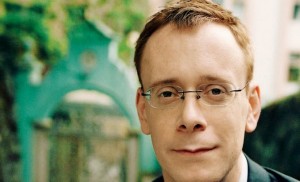Do you know that in 1795, French despot Napoleon Bonaparte offered 12,000 francs as a reward for a grand challenge to preserve food?
Or that Nike’s gamified platform Nike+ helped it to capture nearly 50% of the running shoe market?
Do you know that in 1795, French despot Napoleon Bonaparte offered 12,000 francs as a reward for a grand challenge to preserve food?
Or that Nike’s gamified platform Nike+ helped it to capture nearly 50% of the running shoe market?
Brendon Burchard (source of image)
What makes us truly alive in whatever we do? How can we lead lives brimming with energy, engagement and enthusiasm?
Enter The Charge. Subtitled “Activating the 10 Human Drives That Make You Feel Alive”, this easily read tome provides lots of fodder for anybody seeking to achieve more with life.

Courtesy of AARP
How do you define success? Can it be measured by wealth or power alone?
Apparently no. Not least according to Arianna Huffington, founder and editor of Huffington Post Media Group – one of the world’s most influential news and information brands. In her latest book Thrive, Huffington proposes that there is a “third metric” which quantifies success by one’s well-being, wisdom, sense of wonder, and ability to give.
What should we do when life throws us lemons? After all, we are living in a flawed world and are prone to anxieties, guilt, torment, depression, and all kinds of problems.
The answer, according to Pastor Joseph Prince, is to believe right. In his latest book, The Power of Right Believing, Prince teaches that “right believing always produces right living” and allows us to “let go of a life of defeat and step into a life full of victory, security, and success”. Focusing our thoughts on God’s love and mercy yields far better outcomes than believing in unhealthy emotions which lead to “toxic feelings of guilt, shame, condemnation, and fear” and ultimately negative behaviors, actions and addictions.
Let’s do a little quiz.
How many of you know who Lim Chin Siong or James Puthucheary were?
Or this formidable sounding dude called “The Plen”?
Stumped? Don’t worry. I was just as clueless.
Hopefully that will change with the re-launch of The Battle For Merger. Narrating how our first PM Lee Kuan Yew wrestled control for Singapore from communist insurgents, the book is published jointly by the National Archives of Singapore and Straits Times Press.
Brainchild of DPM Teo Chee Hean, the reprint of The Battle For Merger chronicled the series of radio broadcasts by former PM and Minister Mentor Lee Kuan Yew (LKY). Updated from the original edition published way back in 1962, it contains the transcripts of 12 radio talks written and delivered by Mr Lee between 13 September and 9 October 1961.

People photo created by tirachardz – www.freepik.com
The ageing consumer is one of the most profitable yet untapped segment. Every year, billions of dollars are left on the table by companies around the world as they ignore this increasingly influential and affluent group of consumers.
Consider this.
Nassim Nicholas Taleb is a maverick and a genius.
Renowned for his bestselling book The Black Swan (you can read this Wikipedia entry to learn what Black Swan Theory is), this brilliant former hedge fund manager/ derivatives trader turned university professor is known for philosophical theories which challenge conventional wisdom. Often, these are not just empty musings, but grounded in hardcore mathematical formulas and analyses.
Thanks to a talk organised by the National Library Board titled Antifragility: Gaining from Volatility, Stress and Disorder, I learned a little about why current thinking on risks may be flawed.
Follow me now as I try to convey the essence of Nassim’s talk in layman terms.
Before we can learn what antifragility is, we first need to understand what fragility is.
A cup of coffee can be understood as a fragile object. It is fragile because “it wants tranquility and a low volatility environment”. It hates disorder, variability, randomness, trauma, or other “stressors” and exhibits a “concave” or negative sensitivity to an increase in volatility. There is no upside for a cup of coffee from a random event like a sudden change in weather, a falling piano, or a car crash.
Conversely, an antifragile entity is the exact opposite of the fragile. It needs variability and volatility. High volatility increases its welfare. Hence, it is described as an item with a “convex” or positive sensitivity to increases in volatility (or variability, stress, dispersion of outcomes, uncertainties, and shocks).
Note that being antifragile isn’t quite the same as being robust or resilient. Robustness is about withstanding external shocks and staying the same. The antifragile actually becomes better.
To better understand this concept, do consider the two curves below (courtesy of Innolution):
To better understand how this epistemological principle works in real life, Nassim gave a few interesting examples during the Q&A part of his talk. I’ll go through each in turn.
In the arenas of financial investments, Nassim’s book suggested that one could adopt a “barbell” strategy to take advantage of the “Black Swan” phenomena (ie random, unexpected events with large effects). This entailed spreading one’s eggs on extremely low and high risk instruments rather than middle risk options.
For example, one could invest say 90% of one’s capital in very safe options (eg short-term treasuries, government bonds, gold) that just barely beat inflation (eg gains of 5% per annum) on one side of the barbell. On the other spectrum, one could invest 10% of one’s capital in very speculative and volatile stuff (eg futures, options and derivatives).
The idea behind this is that there is minimal downside if the speculative investments turn sour (90% of one’s capital base is still intact). On the other hand, the gains could be significant should risky investments skyrocket due to “Black Swan” effects.
On the success of cities, Nassim hypothesised that maritime cities with little natural resources are usually more antifragile than those with abundant natural resources. A case in point is Singapore, which started its road towards nation building under adverse circumstances.
Citing the example of how the Phoenicians had to build boats to transport copper from Cyprus, he added that the spare capacity of their boats spurred them to trade in other items. Over time, this “import and export” mentality helped such cities to prosper. Conversely, nations that have abundant resources (eg oil rich states in the Gulf) could be highly fragile as living in the lap of luxury could dampen their competitiveness.
For Singapore, Nassim warned that our prosperity over the past few decades could be a double-edged sword. If we become too rich and complacent, we should perhaps have “summer camps” to toughen our youngsters up lest they lose the fighting and competitive spirit!
According to Nassim, most of the major religions in the world have elements of antifragility ingrained into them. They are “mutations” of what occurred in history, and have fitness built into them. Often, they are also constructed to provide a period of “deprivation” to counter the opulence and excesses and civilisation.
A case in point is religious fasting. Orthodox Christians fast over 200 days in a year, abstaining from meat, alcohol, or other “dietary vices”, while Muslims embark on a 40 day fast as part of Ramadan. Such practices have actually been shown by Medicine to be beneficial for the body, helping to curb diseases like Alzheimer’s or Parkinson’s. For Islam, it was instituted during a time where many of the people in the Middle East were pre-diabetic!
In the field of healthcare, Nassim suggests that we should try not to take drugs for small ailments if our bodies can take it. He cited those who frequently medicate themselves for minor ills tend to have shorter expectancies than those who fight to overcome their sicknesses. We should only seek medical intervention for major life-threatening illnesses (eg cancer).
Anybody who has taken antibiotics to combat their fevers and sore throats would know how weak they feel after the incident. Studies have shown that irradiation therapy for cancerous cells may inadvertently induce the relapse of cancer at a later stage in life.
Similarly, the “stressors” induced by regular moderate exercise helps us to build stronger healthier bodies. Eating less rich diets – for example, more vegetables/salads and less meat – helps our bodies to be fitter. Likewise, we may not want to sanitise our environments so much that we fail to build up our resistance against germs.
Nowadays, kids have schedules as busy as CEOs. Shuttled from point to point for music classes, enrichment classes and other activities, they are so mollycoddled and spoon-fed that they are not exposed to the vagaries of life. Often, such kids eventually end up in professions like investment banking, management consulting, and law.
For a country, however, such a focus on education is actually bad for its economy. In fact, up to a certain point, an increase in educational levels in a country does not equate to increases in GDP. On the contrary, what a country may need are more college dropouts who become entrepreneurs. They include the likes of Steve Jobs (Apple), Bill Gates (Microsoft), Mark Zuckerberg (Facebook) and Larry Ellison (Oracle).
In a related fashion, we should leave our children to experience small failures so that they can toughen themselves up for bigger setbacks in life. This could mean subjecting them to certain degrees of uncertainty and volatility so that they could learn to swim with the sharks later on in life.
Towards the end, Nassim raised the example of how the multiple wars in Lebanon helped its people to do very well. I guess a similar principle applied to how maritime city states like Singapore have prospered during its early tumultuous years. Such effects are termed as post traumatic growth by Nassim.
To benefit from post traumatic growth, we should allow our systems – whether biological, societal or economic – to experience small degrees of disorder and stresses without intervening. We should only “hyper-intervene” when things go really bad, like when the failure of a company could bring down the entire economy.
As the saying goes: “that which does not kill you, makes you stronger”.
What are your thoughts on Nassim Nicholas Taleb’s ideas on antifragility? Will it work for you?
Why are some folks blessed with riches while others struggle to make ends meet? What is the magic formula to wealth?
The answer, according to renowned millionaire guru T. Harv Eker, is found in one’s money blueprint. In his bestselling book, Secrets of the Millionaire Mind, Eker urges us to change our personal money blueprint and reprogramme the way we think, feel and act in order to achieve mastery over our wealth, attain financial freedom, and lead more meaningful lives.
What is the fastest growing yet often neglected consumer group? One that has contributed to a demographic bulge of about 77 million people in the US?
Yes, I’m talking about the Baby Boomers, i.e. those born from 1946 to 1964. Hitting their silver years over the next decade or so, Baby Boomers represent the largest age-related demographic group in the world today. In China alone, it is predicted that the 50+ marketplace will swell to a staggering 525.8 million people by 2025.

Ben Simpfendorfer of Silk Road Associates
Are China and India still the “factory” and “outsourced service provider” of the world? How big is the market for Muslim-friendly products and services? What are the promises and perils of trading in the East?
In a sweeping expose on the dynamic forces shaping the “New East”, Ben Simpfendorfer’s The Rise of the New East provides an in-depth view of how the economic resurgence of Asia and the Middle East are changing global markets. Spanning halfway round the globe – from Turkey to the United Arab Emirates to India, South East Asia and China – the book brings one on a fascinating tour of the complex business characteristics governing our neck of the woods.